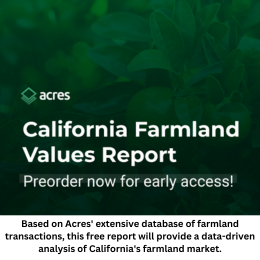February 28, 2024
By S2G Ventures
This is the third and final installment of a series looking back on S2G Venture’s report, Trends Shaping the Future of Food in 2023. Read Part 1 of this series, Reflections on 2023 AgTech Trends, and Part 2, “Reflections on 2023 Food and Agriculture Supply Chain Trends.”
In March of 2023, we published a white paper entitled “Trends Shaping the Future of Food in 2023.” Almost a year later, we explore the year’s events that influenced the evolution of each trend and our view on its momentum going into the new year. In this article, we look back on our 2023 Food Tech trends.

In 2023, we said, “Given the fast-growing consumer awareness, escalating government regulations, increasing manufacturer commitments, and clever suppliers and startups’ innovation, sustainable packaging solutions will achieve value and functionality parity, gaining market share.”
Both sizeable obstacles and meaningful progress marked the path towards sustainable packaging this year. A new report from Tetra Pak revealed high levels of consumer support for sustainable packaging. However, many companies are struggling to implement changes due to supply chain constraints and increased prices, and consumers need more clarity on sustainable packaging materials. Policy is playing an important role in igniting a packaging revolution, with 43 bills introduced in 14 states across the U.S. related to Extended Producer Responsibility (EPR) and packaging. But a recent study found that despite the impact EPR legislation has and will have on companies, just over one-third of the 60 executive participants surveyed said their business was looking at the effect of EPR legislation on their packaging.
While the scale of the issue remains daunting, there is a sense of excitement as innovative solutions and critical developments emerge. Companies increasingly recognize the imperative to address the plastics problem, with initiatives like Mars Inc. launching new sauce bottles resulting in an 18 percent reduction in virgin plastic usage and working to develop a draft of the world’s first legally binding treaty to eliminate plastic pollution. The USDA’s approval for S2G portfolio company Circulus to produce 100 percent post-consumer resin suitable for direct-food-contact packing applications is a significant milestone, indicating progress toward circular economies. Researchers are discovering and developing microbes and enzymes to break down plastic or turn it into fully biodegradable materials. The emphasis on biopolymers as a route to scale bioplastics and home-compostable plastics reflects a strategic shift towards more sustainable materials. While acknowledging the time required to achieve cost parity and retool manufacturing systems, we believe the sector’s trajectory is on an S-curve, with more climb ahead before reaching lift-off in the journey towards sustainable packaging and closed-loop recycling.

In 2023, we said, “Alternative proteins are still in the iPod phase – not yet the iPhone phase. There is still tremendous progress to be had in this sector through the introduction of novel ingredients.”
Alternative protein has not had an easy few years, with a 42 percent drop in funding in 2022. However, a December 2022 global survey of 125 alternative protein investors found they are still cautiously optimistic about the space. Ingredient discovery platforms are beginning to churn out healthier ingredients that provide an improved eating experience. For example, S2G portfolio company MycoTechnology last July discovered a natural sweet protein from honey truffle that could reduce sugar intake.
Scale is still a challenge, which will take substantially more time, money, and effort, as companies figure out how to design new production systems that can take the technology beyond the realm of startups to large-scale supply chains. However, progress is being made – from New Culture, an S2G portfolio company, scaling up its fermentation process to enable the production of 25,000 pizzas worth of cheese per run; to MycoTechnology launching a fermentation as a service platform to help startups secure fermentation capacity in a tight market – providing more opportunities for companies to move to commercial scale. Pow.bio, a company hoping to change the economics of precision fermentation, also raised a $9.5 million Series A round.
Large-scale companies in the value chain are also increasingly thinking about how they can use their resources to partner with innovative startups and bring new products to market at scale. In 2023, we saw Danone invest in S2G portfolio company Imagindairy with plans for strategic collaborations, Shake Shack’s partnership with S2G portfolio company Zero Acre to pilot clean frying oil, and ADM teaming up with Air Protein to help scale their production platform, which uses carbon dioxide instead of sugar to fuel microbial fermentation.

In 2023, we said, “The technology for protein cultivation is ready for commercialization, and it continues to improve. To bring a product to market, companies need to focus on reducing the cost of production, brand-building, labeling, consumer education, and improving supply chain and inputs to support a scalable industry.”
The current state of the cellular meat industry is characterized by both challenges and promising developments, reflecting the unique complexities of biomanufacturing meat at scale. The approval for Upside Foods and Good Meat to sell their cultivated chicken products in the U.S. represents a huge regulatory milestone. But with no established playbook in place, many companies face hurdles that we expect to continue into the coming year. Securing funding remains a critical challenge, and companies will have to carefully manage their resources for an extended period, given the uncertainty about when funding might pick up again.
Despite these challenges, there have been a number of positive developments. Creativity in replacing high-cost ingredients has led to considerable cost reduction, and companies are leveraging big data, AI, and machine learning to enhance feed conversion rates and understand the metabolic factors influencing cell growth. Advancements in the speed and efficiency of cell differentiation processes also contribute to the industry’s maturation.
Other noteworthy signals of industry growth include Brazilian meatpacker JBS starting construction on the world’s largest lab-grown meat plant. Governments, including the U.S. and European nations like the Netherlands and Germany, are allocating significant funds to support biotech and biomanufacturing in the cellular agriculture space. Younger consumers, in particular, show a willingness to try cultivated meat, with 60 percent of consumers ages 18 to 34 expressing interest. However, challenges persist in broader consumer acceptance, with some age groups, such as baby boomers, showing reluctance. We expect significant consolidation, but believe that companies that weather the storm will be positioned to build robust, scalable businesses.

In 2023, we said “The convergence of food and healthcare will continue to develop as food and food-derivatives are more accurately linked with health outcomes. Consumers are already searching for more holistic and integrated solutions.”
In 2023, we saw a growing interest in the intersection of food and healthcare from a wide variety of players, including corporates, policymakers, and investors. Grey Green Media’s Food as Medicine Policy Summit was sold out for the first time, reflecting growing interest from the private sector and the convergence between the private sector and public policy. There is also more scientific data backing some of these solutions. A recent study that included nearly 4,000 people in 12 states found that produce prescriptions led to meaningful impacts on health outcomes.
There are a couple of promising solution categories in this sector, one being perioperative nutrition or nutritional interventions within a surgical setting, effectively helping patients get healthier to undergo surgery and recover faster. In 2023, S2G invested in Mend, a platform that elevates patient care through digital health coaching, monitoring, and nutra pharma. Secondly, payers remain interested in using nutrition more effectively in private insurance programs and government service programs like Medicare, Medicaid, and Medicare Advantage. For example, S2G portfolio company NourishedRx partners with healthcare organizations to provide home-delivered meals and nutrition support to their most vulnerable members. Following documented improvement in birth outcomes from a NourishedRx pilot, Blue Plus recently announced an expanded statewide collaboration with NourishedRx in Minnesota to address rising maternal health inequity issues.
Companies hope to use these benefits to reduce chronic disease and other diseases through food, and we are seeing significant momentum behind these solutions. Grocery retailers, in particular, are showing signs of becoming key channel partners in the convergence of food and healthcare, with Kroger launching nutrition-related benefits and medically tailored meal offerings.
In terms of successful business models, we believe pairing food products and a digital platform with some human touch will prove effective for customer adoption and retention. We believe we will continue to see digital health companies move towards incorporating a physical product, such as a food component, in their business models to improve retention rates.
These solutions will take substantial time, longitudinal clinical studies, and investment. But stakeholders increasingly recognize food as health as a powerful solution to our healthcare crisis. Innovative packaging and cultivated proteins have a lot of work ahead, but we believe solutions that offer a product at price parity with substantially reduced environmental impact and equal or better performance will emerge successful.
That’s a wrap on our 2023 trends reflections. We look forward to seeing how these sectors progress in 2024.
Listen to more insights about the food and ag sector in the S2G Podcast.
*The discussion herein only reflects the views and beliefs of S2G Investments, LLC (“S2G Ventures”) based on its research, analyses, estimates and assumptions, all of which may be materially inaccurate or vary across market participants and industries. It is provided for discussion purposes only and should not otherwise be relied upon in any context.
*The content put forth by Global AgInvesting News and its parent company HighQuest Partners is intended to be used and must be used for informational purposes only. All information or other material herein is not to be construed as legal, tax, investment, financial, or other advice. Global AgInvesting and HighQuest Partners are not a fiduciary in any manner, and the reader assumes the sole responsibility of evaluating the merits and risks associated with the use of any information or other content on this site.

Let GAI News inform your engagement in the agriculture sector.
GAI News provides crucial and timely news and insight to help you stay ahead of critical agricultural trends through free delivery of two weekly newsletters, Ag Investing Weekly and AgTech Intel.




